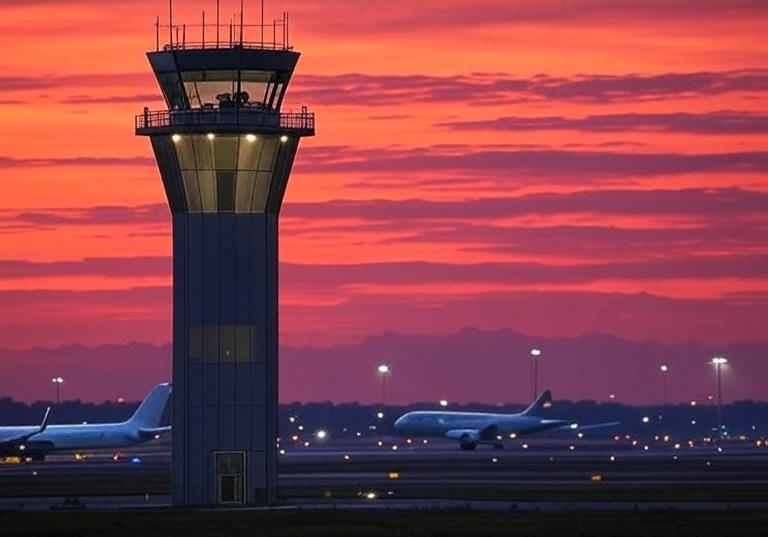As the aviation industry evolves, more airports are evaluating the use of virtual (or remote) towers instead of traditional control towers. While both systems aim to ensure safe air traffic control, they operate in fundamentally different ways. This article provides a complete comparison between virtual towers and traditional ATC towers, outlining their advantages, disadvantages, and which types of airports each system best suits.
What Is a Traditional Tower?
A traditional air traffic control tower is a physical structure located at the airport, typically with a panoramic view of the airfield. Controllers work on-site and rely on direct line-of-sight visibility and audio cues to guide aircraft movements on the ground and in the immediate airspace.
What Is a Virtual or Remote Tower?
A virtual or remote tower allows controllers to manage airport traffic from a different location using a system of high-definition cameras, sensors, microphones, and augmented reality tools. Instead of looking out windows, controllers monitor aircraft via screens and data feeds.
These systems can be used to control one or multiple airports from a centralized, remote facility.
Comparison: Virtual Tower vs Traditional Tower
- Visual and Auditory Perception
Traditional towers provide full real-world perception, controllers see, hear, and feel environmental conditions in real time. Virtual towers rely entirely on video and audio feeds, which can miss subtle cues such as distant bird activity, engine tone changes, or shifting winds. - Low Visibility and Weather Performance
Traditional towers operate reliably in all weather conditions, including low-visibility (CAT II/III) situations. In contrast, remote towers may struggle during fog, heavy rain, or snow if camera performance degrades or visibility sensors fail. - Handling Complex or Mixed Traffic
Airports with mixed IFR/VFR traffic, helicopters, military activity, and frequent runway crossings are better served by traditional towers. Remote towers are not fully capable of managing such complexity without operational compromises. This often means reducing the airport’s capacity, limiting simultaneous operations, or imposing procedural restrictions, all of which can impact efficiency and delay traffic. - Technology and Augmented Vision
Virtual towers offer advanced tools such as object tracking, night vision, zoom, infrared cameras, and AI overlays. However, while traditional towers can integrate cameras, night vision, and zoom, AI overlays are not feasible due to their reliance on remote data processing. That said, AI overlays are largely a technical gimmick, offering little practical benefit for air traffic control. - Location Flexibility
Remote towers can be operated from anywhere, which allows for centralization (e.g., Norway’s system managing multiple airports from one center). This flexibility also supports contingency operations. However, it also increases risks related to outsourcing. - Construction and Maintenance
Building a traditional tower might be more expensive upfront due to infrastructure costs. But over time, maintenance of virtual towers, with dozens of high-tech cameras, software systems, and networks, will become equally or even more costly. - Cybersecurity and System Resilience
Traditional towers are physically secured and isolated from major cyber threats. Virtual towers rely on internet-based or private network connectivity, making them more vulnerable to cyberattacks, data breaches, and communication failures.
- Visual and Auditory Perception
Comparison Table: Remote/Virtual Tower vs Traditional Tower
| Aspect | Traditional Tower | Remote / Virtual Tower |
|---|---|---|
| Direct visual & auditory input | ✔️ Full real-world perception (eyes/ears) | ❌ Limited to video/audio feeds (can miss subtle real-world cues) |
| Low-visibility ops (e.g., CAT II/III) | ✔️ Proven performance in fog, snow, heavy rain | ❌ Camera reliability in adverse weather still a concern |
| Complex/mixed traffic handling | ✔️ Better for high-volume, diverse traffic environments | ❌ Remote setups may struggle with complexity and airspace saturation |
| Failure resilience (tech & power) | ✔️ Localized redundancy (generators, backups); not dependent on network | ❌ Network, server, or camera failures affect operability |
| Enhanced visibility tools (IR, AI overlays, zoom) | ✔️ CAN be added in modern traditional towers too with some exceptions | ✔️ Built-in by design in virtual systems |
| Scalability & cost-efficiency | ❌ High upfront construction cost; less flexible | ✔️ Can serve multiple airports; lower initial cost per site |
| Maintenance over long-term | ✔️ Mostly structural/IT maintenance | ❌ Ongoing camera upkeep, sensors, data lines, software patches = cost buildup |
| Remote operation flexibility | ❌ On-site only | ✔️ Can be operated from anywhere (even cross-country, e.g., Norway’s system) |
| Risk of outsourcing/control loss | ✔️ Highly secured, physical control | ❌ Risk of operational outsourcing, cybersecurity, and vendor dependency |
| Cybersecurity | ✔️ Limited attack surface (isolated systems) | ❌ Increased exposure due to remote links, cloud, and data reliance |
Which Is Safer and More Suitable?
Virtual towers are best suited for:
- Low-traffic regional airports
- Airfields in remote or hard-to-access locations
- Backup or contingency systems for larger hubs
Traditional towers remain safer and more robust for:
- Medium to high-traffic airports
- Airports with complex layouts or traffic mixes (IFR/VFR, helicopters, training flights)
- Airports with operational needs in low-visibility conditions
For example, London City Airport is one of the only medium-traffic airports (~40,000 movements per year) using a remote tower at the moment. It functions well primarily because of its simple layout and limited aircraft types. However, it closes under visibility conditions below 1,500 meters, something unacceptable for airports serving as the sole gateway to a region or country.
Technology Should Support, Not Replace Proven Safety
Although it is technically feasible to implement virtual towers, and the concept looks impressive on paper, not every technical possibility should be pursued simply because it is achievable. A comparable case: it is also technically possible to operate commercial aircraft with only one pilot, but neither pilots, air traffic controllers, nor passengers support that idea. The only people in favour of such reductions are often those focused on short-term cost savings.
But aviation is not the industry where cost-cutting should come before safety. The top priority must always be operational safety, redundancy, and reliability. Air traffic control must be adequately staffed, and while new technologies and digital tools are welcome, they should support—not replace—core infrastructure that has been proven to work safely for decades.
Modernization is important, and both ATC personnel and pilots consistently support innovation. However, they are also the experts who work with these systems every day. Their experience, situational awareness, and feedback are critical and should be respected in any decision-making process regarding operational changes at airports.
Conclusion: Virtual Tower or Traditional Tower?
While virtual towers are an innovative and flexible solution for smaller, low-density airports, they currently offer no significant advantage over traditional towers in complex or high-traffic environments. The long-term operational safety, human awareness, and independence of a traditional tower remain unmatched. For countries or cities with only one main airport, operational reliability under all conditions is critical, making the traditional tower the more secure and dependable option.
For a deeper dive into remote tower feasibility, explore our study at ELLX: Remote Tower Feasibility Study


